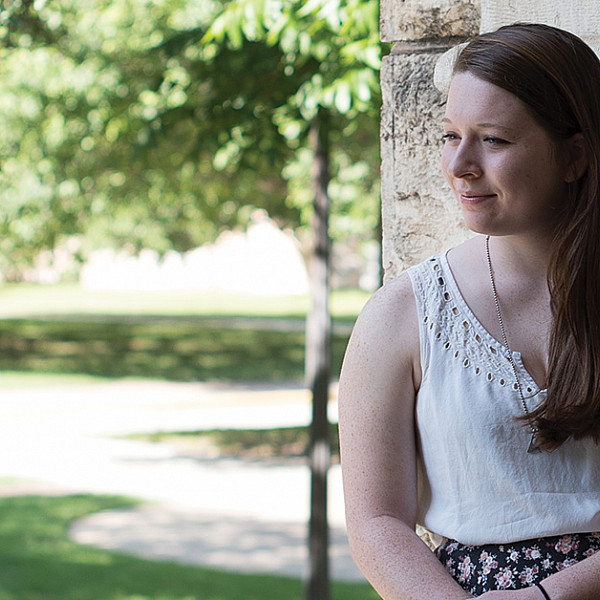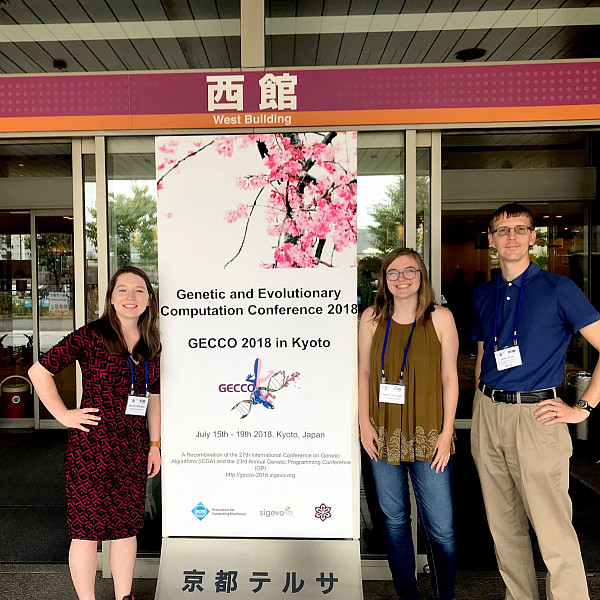News
Computers and Creativity
April 22, 2021
April 22, 2021
Open gallery

Higher-education researchers and the experts who staff university career centers will tell you that internships are crucial to both a college student’s professional development and their chances of landing a job quickly after graduation. Anna Krolikowski ’20 is certainly anecdotal proof of that advice. While still in high school, the Greenfield, Wisconsin, native began a six-year internship in graphic design at Iit/SourceTech, a small software company, and she happily returned to that position each summer and winter break while attending Southwestern. In May 2020, Krolikowski graduated from SU with degrees in English and computer science—and was immediately promoted to a full-time position as a software developer at her company.
The young alum was grateful to have a job she enjoys already in hand when she graduated. She was also excited to return to the Milwaukee area. “When I was initially researching schools, I thought I wanted to go somewhere really far and preferably somewhere warm. I was very much in that spread-my-wings mindset,” she says. “Then I got to school, and I realized that I really value being close to my family.”
So what kept her in Georgetown? “I loved Southwestern so much that I stayed,” Krolikowski shares.
The importance of stories
As a first-year student, Krolikowski knew she wanted to major in English. She confirmed and broadened her interest in children’s literature by studying some of the classics of the genre, such as Peter Pan and Alice in Wonderland, in Eileen Cleere’s Transatlantic Children’s Literature, a course that would later inspire her English capstone, in which she researched and wrote about the self-sacrifice trope in Barrie’s novel and Harry Potter and the Sorcerer’s Stone. She also loved Novel English Majors with Helene Meyers. “It was all about having an English degree and what to do with an English degree,” she describes. “I found it so inspiring and useful… . I wish that all humanities majors could take that class!”
But as she continued her internship back home during school vacations, Krolikowski became more interested in learning CSS and HTML as well. “I liked working with user interfaces,” she explains. “I liked thinking about what we call user stories, and that’s how it ties into English: when you’re designing software, you often have to think about the story behind [its users], like Why is somebody using this? What is the exact purpose?” Many might assume that English and computer science don’t intersect, but Krolikowski knew that her studies in literature only enhanced her ability to answer those important technological questions.
Still, Krolikowski admits that wasn’t sure at first whether she’d be able to pull-off double-majoring in four years, especially considering that she had her sights set on studying abroad the fall of her sophomore year in London. But thanks to the university’s flexible curriculum and the support of her advisor, Associate Professor of Math and Computer Science Jacob Schrum ’06, she was able to accomplish her academic goals and still graduate on time. “I really, largely credit Dr. Schrum for helping me with that,” Krolikowski says appreciatively. “I feel like at any other school, they would have been like, ‘No, this is not going to work.’ But Dr. Schrum was like, ‘We’re going to make this work.’”
The allure of college courses? Specialized topics
Krolikowski flourished during her London semester, taking classes that she describes enthusiastically as “amazing,” “super cool,” and “really fun.” She loved studying the Tudors with Associate Professor of History Jessica Hower, and with Professor of Sociology Sandi Nenga, she got to learn about how pop-culture juggernauts such as Sherlock (the series starring Benedict Cumberbatch and
In addition to having the opportunity to travel across the Atlantic, Krolikowski cherishes the mentorship she enjoyed with her professors in London. She says that programs such as study abroad and the small college environment back on the Southwestern campus allowed her to personally connect with so many mentors: Schrum, Meyers, Cleere, Hower, and Nenga, as well as Barbara Anthony and Michael Saenger (her “fantastic” computer science and English capstone professors, respectively), “have all been incredibly supportive” of her learning and growth.
But she also appreciates the creativity of the faculty, which is reflected in the fascinating and focused topics they teach within their fields. “Part of the thing that I like about college courses is that they’re more targeted toward things that I enjoy or things that I’m interested in,” she explains. For example, in high school, students often take survey-style courses: an entire year is often devoted to covering enormous subjects such as British literature, world history, calculus, or physics. By contrast, Krolikowski says, “Southwestern is a bit unique because it has some really cool classes that you can take that are specialized, like the Transatlantic Children’s Literature class. Or I took an American Gothic class with [English professor Jim] Kilfoyle, and I loved that course! … Or like with computer science, taking an Artificial Intelligence course was something I was really interested in.” She adds that being able to choose and learn about narrower topics that her professors are passionate about translated to much more dynamic classroom conversations and engagement than she was used to in high school—a common refrain one hears among SU students.
Entangled in Zentangles®
While taking the Artificial Intelligence course in spring 2019, Krolikowski began a long-term research project inspired by classmate Sarah Friday ’20, an art and computer science major. Together, they worked on using AI to create Zentangles®, a meditative art form in which an individual draws borderlines on paper and fills in the shape with different patterns, resulting in an abstract piece of art. The collaborators used an algorithm known as wave function collapse and modified an evolutionary art application called PicBreeder to create those patterns. Schrum persuaded Friday and Krolikowski to report their findings in a presentation and a research paper, “Quantum Zentanglement: Combining Picbreeder and Wave Function Collapse to Create Zentangles®,” which the pair presented virtually last spring at EvoMUSART, an international conference on artificial intelligence in music, sound, art, and design. The project garnered encouraging feedback from the panel’s participants.
For Krolikowski, the most rewarding part of the Zentanglement research was “getting the results.” She believes that she’s not alone among computer scientists in understanding that “it’s very, very difficult to get things to work, and at points, you just want to repeatedly hit your head against something. But when you do get it to work as you wanted it to work, it’s an addictive little thrill, like, ‘Oh my gosh, it’s actually doing it!’”
Ultimately, though, her investment in the project resulted from the chance to blend art with technology and to do the kind of creative thinking that’s required when developing ideas to continually improve a process. “I was really interested in that line between computer science and creativity,” Krolikowski says of the project that resulted in her first professional publication. “That’s what really drew me in, especially because I had worked in graphic design for a while at that point. So even though art was never an official major for me and I wouldn’t call myself an artist, I was very interested in that creativity aspect of it… . It’s a really cool project.”
A supportive community
Krolikowski may consider applying for graduate programs at some point in the future, especially those that would allow her to further explore the intersection between computers and creativity, but for now, she is more than content at her Iit/SourceTech job. “I really enjoy software development,” she shares. “It’s challenging, and I love the people that I work with. It’s a really good group. They’re really, really nice and fun, very upbeat people.”
“The community is really what drew me to Southwestern in the first place.”
She also is thankful to again be close to her family back in Wisconsin. Nevertheless, she does miss the close-knit small-college environment of SU. “I know a lot of people say this and that it’s kind of a nebulous answer,” she laughs, “but the community is really what drew me to Southwestern in the first place… . I loved the smaller class sizes where you could have discussions. I loved the idea of having such good relationships with my professors. And I really liked the fact that I made friends in first-year seminar who I kept through the rest of the time that I was at school. It’s a great community!”
As for students who might also want to major in both a humanities and a STEM field, Krolikowski warns that “you really do have to work hard.” However, she says that at Southwestern, you’ll have advisors and advocates who will help you make it happen. “The professors will support you if you make that decision. So be prepared to work hard,” she suggests, “but also, don’t let that deter you from thinking that you can’t do it. You absolutely can do it, and it’s really a great feeling to graduate with both of those majors. It makes you a more unique candidate going into the job force. I absolutely recommend going for it.”


















